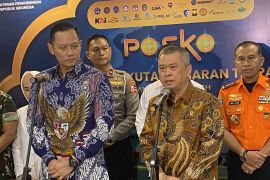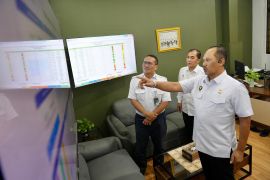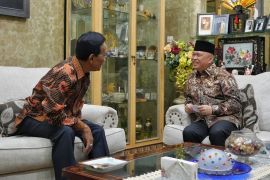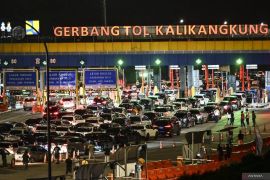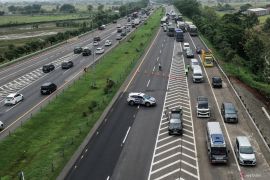Mudik means that migrants return to their hometowns, generally several days ahead of Eid.
Homecoming trips can be undertaken by opting for different transportation modes of airplanes, ships, and private vehicles. Although the travel time is long in these modes, presently, driving off in private vehicles using the land route to return home is found to be more attractive, particularly for travelers on Java Island, owing to the presence of the Trans Java Toll Roads.
Along the Semarang-Solo toll road, for instance, motorists are spoilt for choice in terms of the plethora of views of the forests and rice fields. On the Semarang-Ungaran Toll Road, drivers can soak in the myriad views of the Pine Forest. As one enters Bawen, the traveler is overwhelmed by views of the Banaran Coffee Plantation.
While traveling from Salatiga to Solo, the scenery on either sides of the road is largely dominated by rice fields.
Fascinatingly, to relieve weariness in the middle of a lengthy journey, the driver can, during the journey, explore a popular tourist attraction of the historic De Tjolomadoe building in the Soloraya region that is not far from the toll gate.
The building in Colomadu Sub-district, Karanganyar District, is located merely some three kilometers from the entrance of Tol Ngasem, Kartasura.
One then has to exit the Ngasem Toll Gate, veer the vehicle to the left until one reaches the first traffic light and then take the left to head to the Student Army Road.
Arriving at the first traffic light, at the Colomadu Market intersection, the vehicle is then driven straight ahead. The De Tjolomadoe building is located some 300 meters from the intersection to the right of the road.
The entry fee for each visitor to this recently inaugurated tourist attraction in mid-2018 is Rp25 thousand.
Full machine
Taking into account that the tourist attraction was earlier a Colomadu Sugar Factory, several machines are still installed in numerous buildings in the area.
Despite being several centuries old, these gigantic machines still appear in good shape and are sturdy, particularly after the revitalization costing nearly billions of rupiah.
Apart from being enthralled by the sights of these sturdy machines, visitors are also invited to enjoy a new and memorable experience at the De Tjolomadoe Museum.
Taking the concept of educational tourism a notch higher, the Museum De Tjolomadoe showcases dioramas, primeval archives of the Colomadu Sugar Factory, and the historical video of the Mangkunegaran IV relic factory.
Marketing Manager De Tjolomadoe Achmad Ridho stated that the Wagis Wara Park at the museum was a result of collaboration with artists from Yogyakarta.
"The concept is based on glow in the dark. This is quite interesting for visitors to explore. Although the concept is a museum, but the De Tjolomado Museum is guaranteed to be far from monotonous and boring," he emphasized.
With the bevy of information being presented, the manager is upbeat that visitors would be enlightened by the magnificent journey of the Colomadu Sugar Factory.
"Even when it is no more, it will continue to draw representatives from Thailand to gain insights into the science of sugar factories. It is expected that visitors can then propagate this wealth of information pertaining to the history of the Colomadu Sugar Factory to the people around," he stated.
Moreover, a large parking location in the area can accommodate hundreds of four-wheeled vehicles.
Culinary tour
After exploring De Tjolomadoe, travelers can simultaneously continue their culinary tour in the city of Solo that has varied unique culinary delights for the nomads, including timlo, tengkleng, nasi liwet, sate buntel, and Solo strait.
A place worth visiting to sample culinary delicacies is Pak Manto Goat Satay. After De Tjolomadoe, while waiting for the Magrib drum, travelers can drive to Jalan Slamet Riyadi, Solo.
At the intersection of Ngapeman or Sami Luwes, the visitor should then drive to the right. Some 300 meters from the intersection is Pak Manto's Goat Satay located to the right of the road.
To ensure no waiting, visitors should arrive at least an hour or two prior to breaking the fast.
Some of the items on the menus in Pak Manto Goat Satay comprise a portion priced at Rp57 thousand; a serving of tengkleng rica at Rp68 thousand, godog rice at Rp40 thousand per portion, Rp64 thousand per serving of satay, goat fried rice at Rp40 thousand per portion, Rp57 thousand for a serving of goat satay, buntel cook priced at Rp63 thousand per serving, and cook at Rp57 thousand per portion.
Several food lovers are interested in tengkleng rica and satay buntel. Tengkleng rica is quite special, as it is served in large portions.
This menu is only suitable for those fond of piquant food, as the high spice quotient is not only from cayenne but also pepper. Your vegetable fiber supply will be adequately met with the chunky pieces of cabbage added to every portion by the sellers.
Editor: Suharto
Copyright © ANTARA 2019






